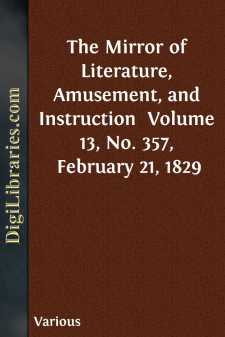Categories
- Antiques & Collectibles 13
- Architecture 36
- Art 48
- Bibles 22
- Biography & Autobiography 813
- Body, Mind & Spirit 142
- Business & Economics 28
- Children's Books 15
- Children's Fiction 12
- Computers 4
- Cooking 94
- Crafts & Hobbies 4
- Drama 346
- Education 46
- Family & Relationships 57
- Fiction 11829
- Games 19
- Gardening 17
- Health & Fitness 34
- History 1377
- House & Home 1
- Humor 147
- Juvenile Fiction 1873
- Juvenile Nonfiction 202
- Language Arts & Disciplines 88
- Law 16
- Literary Collections 686
- Literary Criticism 179
- Mathematics 13
- Medical 41
- Music 40
- Nature 179
- Non-Classifiable 1768
- Performing Arts 7
- Periodicals 1453
- Philosophy 64
- Photography 2
- Poetry 896
- Political Science 203
- Psychology 42
- Reference 154
- Religion 513
- Science 126
- Self-Help 84
- Social Science 81
- Sports & Recreation 34
- Study Aids 3
- Technology & Engineering 59
- Transportation 23
- Travel 463
- True Crime 29
The Mirror of Literature, Amusement, and Instruction Volume 13, No. 357, February 21, 1829
by: Various
Categories:
Description:
Excerpt
WARWICK CASTLE.
The history of a fabric, so intimately connected with some of the most important events recorded in the chronicles of our country, as that of Warwick Castle, cannot fail to be alike interesting to the antiquary, the historian, and the man of letters. This noble edifice is also rendered the more attractive, as being one of the very few that have escaped the ravages of war, or have defied the mouldering hand of time; it having been inhabited from its first foundation up to the present time, a period of nearly one thousand years. Before, however, noticing the castle, it will be necessary to make a few remarks on the antiquity of the town of which it is the chief ornament.
The town of Warwick is delightfully situated on the banks of the river Avon, nearly in the centre of the county to which it has given its name, and of which it is the principal town. Much diversity of opinion exists among antiquaries, as to whether it be of Roman or Saxon origin; but it is the opinion of Rous, as well as that of the learned Dugdale, that its foundation is as remote as the earliest period of the Christian era. These authors attribute its erection to Gutheline, or Kimbeline, a British king, who called it after his own name, Caer-Guthleon, a compound of the British word Caer, (civitas,) and Gutieon, or Gutheline, which afterwards, for the sake of brevity, was usually denominated Caerleon. We are also informed that Guiderius, the son and successor of Kimbeline, greatly extended it, granting thereto numerous privileges and immunities; but being afterwards almost totally destroyed by the incursions of the Picts and Scots, it lay in a ruinous condition until it was rebuilt by the renowned Caractacus. This town afterwards greatly suffered from the ravages of the Danish invaders; but was again repaired by the lady Ethelfleda, the daughter of King Alfred, to whom it had been given, together with the kingdom of Mercia, of which it was the capital, by her father. Camden, with whose opinion several other antiquaries also concur, supposes that Warwick was the ancient Præsidium of the Romans, and the post where the præfect of the Dalmatian horse was stationed by the governor of Britain, as mentioned in the Notitia.
The appearance of this town in the time of Leland is thus described by that celebrated writer:—"The town of Warwick hath been right strongly defended and waullid, having a compace of a good mile within the waul. The dike is most manifestly perceived from the castelle to the west gate, and there is a great crest of yearth that the waul stood on. Within the precincts of the toune is but one paroche chirche, dedicated to St. Mary, standing in the middle of the toune, faire and large. The toune standeth on a main rokki hill, rising from est to west. The beauty and glory of it is yn two streetes, whereof the hye street goes from est to west, having a righte goodely crosse in the middle of it, making a quadrivium, and goeth from north to south." Its present name is derived, according to Matthew Paris, from Warmund, the father of Offa, king of the Mercians, who rebuilt it, and called it after his own name, Warwick.
The castle, which is one of the most magnificent specimens of the ancient baronial splendour of our ancestors now remaining in this kingdom, rears its proud and lofty turrets, gray with age, in the immediate vicinity of the town....












